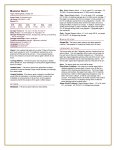I think you miss-understood. I agree that the bite attack is an important part of the monster. The issue I have is the idea of a humanoid attempting a bite attack without first gaining some control of the target (i.e. a grapple).
Well sharks are a bad example as they have no choice. I believe I addressed that in my question to you. Regardless, I get your point, it does wall into the ghoulish theme for it to reckless bite (perhaps without proficiency?). It could possibly work with the ghoul. However, the idea of a giant ghoul bending down an leading with its head seems a bit silly to me. Personally I prefer to go with claw/claw w/ grapple + bonus bite or a bite that replaces the claw/claw attack. The single bite represents the extra time/effort/complexity of getting the head into position for a bite without a proper grapple.
I apologize, I think I was unclear and came off a little aggressive. I wasn't trying to bash your suggestion, I was trying to get your take on what I see as a world building issue with some MM monsters. Does it bother you that the claw/claw/bite routine this is a rather common thing in D&D monsters when there should be some sort of control / grapple before the bite? I would be happy if the bite was just contingent on the monster hitting with a claw or better yet both claws. There doesn't have to be a grapple.
I see, you're asking about the philosophy of monster design. I'm on your page now.
Yes, your interpretation of the action - lean down to grab, lift to mouth and bite - is how I'd do it in my own game too. Personally, I'm very willing to hack monster design to get the result I want, and it's primarily an artistic process for me (I find the maths mostly easy to work out). In this context, however, I was deliberately limiting myself because I realized the OP was coming from a different framework than me. I started to add stuff (like the limb devouring) and then caught myself and stopped. I think [MENTION=6776548]Corpsetaker[/MENTION] was looking for a more 3e style direct translation of "ghast template applied to hill giant, and leveled up."
To your question from my own perspective...Yes, I think claw/claw/bite can feel incongruous, depending on the monster. For example, bullywugs biting as part of a multiattack feels off to me (in the case of the bullywug I'd just give it 2 spear attacks, ignore its bite, and if necessary adjust CR accordingly). OTOH, a bite as part of a multiattack fits quadrupeds like dragons just fine.
More broadly speaking, as DM I've always found narrating a non-lethal bite from a large/huge monster to be challenging; the adult blue dragon bite you...you take 30 damage, you're hurt but you're not dead...um...
Now, I've become more savvy about how to narrate these things, but it still isn't 100% natural, I have to think about it:
The blue dragon clamps down over your head and arm, your magic staff the only thing keeping its jaws from snapping shut. <<I have to be careful to avoid implying any damage to the PC's equipment.>>
Razor sharp teeth dig into your shoulder and a mild electrical current runs through your body, as you can see pinpoints of blue-hot lightning dancing deep in its gullet. In frustration, the dragon dislodges the staff from its mouth, knocking you to your side. <<However, because the attack doesn't knock prone, I have to remember to narrate that the PC recovers and is not Prone.>>
Quickly rolling to your feet, you see crimson blood running down your arm to your fingers.
What's narratively jarring for me is that in movies and literature when a big thing bites a little thing, it's usually curtains for the little thing...unless they're swallowed whole and can escape from inside...or sacrifice a piece of equipment to jam its jaws open.
One of the things that I've come to miss in D&D is players being comfortable with the DM ad-libbing these sorts of complications. Maybe it was just because we were kids and barely knew what we were doing, but I would always be aiming towards creating these kinds of scenes when a bite attack from a big monster came into play. In adulthood with more savvy players and D&D being more transparent, you'd really need players to be onboard with this sort of improvising. I actually was called out on it by some players (who'd adopted D&D during 3e and played 4e) who felt like I was changing the rules under their feet.

